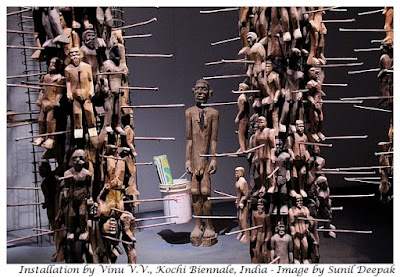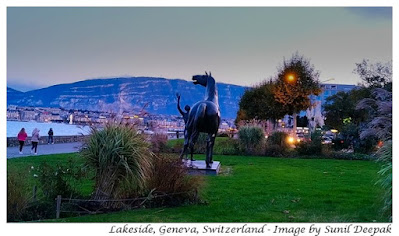My friend Silvio explores and expresses emotions, sensations and feelings through photography. A few years ago, Silvio had a brain-stroke when an artery in his brain was blocked by a blood clot. He was fortunate to survive that experience. During his recovery he discovered a new way of using photography to express himself. (Note: Click on the images for a bigger view)
I was also very much into photography till a few years ago and never went anywhere without my camera. With my work in
 development programmes in different countries, it was a way of documenting as well as, a way of discovering countries, communities and people.
development programmes in different countries, it was a way of documenting as well as, a way of discovering countries, communities and people. Silvio goes into photography in a completely different way, searching for emotions and feelings. His images are about capturing moods, lights, sensations, they do not bother about rules and norms of "good" photography.
For example, I love the water-colour painting like effect he can get in some of his images. This post is about Silvio Faggin, his life and his photography.
Silvio's Life
Silvio was born in Schio, and his first home was in Via Faccin. His father worked in making wooden furniture and he has a brother, 2 years older to him. While his brother wanted to study, Silvio says that he was not very keen to study and started working after finishing the middle school.
His first job was in a pharmacy but he did not like it and changed it after six months, when he heard about a job with a new company making electric systems. He learned on the new job and grew his skills in this field. Though he changed employers but he continued in this field of electric systems for all his working life.
In the mean time he married Patrizia and they have a son.
During mid-1980s, new design systems were introduced for making the electric systems called Programmable Logic Controller (PLC), which used computers and automation. Soon Silvio also got into PLC and thus started to work with computers. Over the years, this work grew into CNC (Computerized Numerical Control) machines. And thus, Silvio's work with computers also grew.
Silvio has travelled widely for work in a large number of countries, especially in North America and Europe. Apart from Italian, he knows Spanish and French, and over the years, has acquired proficiency in English.
Silvio's Brain Stroke
One evening in January 2018, while in the bathroom, Silvio had a brain-stroke. He was fortunate that his wife heard him and called the ambulance, which arrived quickly and took him to the Neurosurgery department in Vicenza hospital, where the doctors were able to operate and re-open his blocked artery. After about 10 days in ICU, he regained consciousness.
The stroke had caused weakness in right half of his body and loss of speech. After his recovery, he slowly regained strength in the right side of the body. However, recovering his capacity to speak took much longer - he had to work for it with a speech-therapist for about 2 years.
Silvio's Special Experience
At the time of the brain-stroke, while he lay unconscious in the bathroom, Silvio had a special experience. He felt that he had separated from his body and was visiting the eternity in the cosmos - however, these words do not express his experience adequately. He finds it to difficult to express this experience in words. He feels that this experience changed him in profound ways but again finds it difficult to explain how.Though now he can speak, but often he continues to struggle with finding the words to express himself. Sometimes, he needs to search for the words on his mobile phone. Thus, conversation with him is punctuated with silences.
While we were talking about out-of-body experiences during the stroke, we joked about his famous cousin, Federico Faggin's book Irreducible, which is about connections between consciousness and quantum physics, (which I have just started to read but find it a little challenging to understand).
Silvio's Passion for Photography
Silvio had a camera before his stroke and he used to take pictures with it, like usual photographs. After the stroke, he discovered a new passion for photography, which was different, in the sense that now it is a way for experiencing and expressing emotions.
He explains it with the following words: "When I see something that moves me or touches me in a particular way, I want to express that emotion through my photography. I manipulate the manual settings of my camera, till I can achieve that particular emotion and click a picture. Often that first picture expresses my emotion and my way of seeing the reality."
The way he explains it, it seems that he is not experimenting with different camera settings to see different effects they can produce, but rather, using a particular setting for achieving a precise effect that he can foresee in his mind.
He downloads those images on his computer and on mobile-phone and likes to look at them to experience and re-live those same emotions.
Photography Without Technical Manipulation
A couple of months ago, I went to see a photo-exhibition with Silvio. I was surprised to discover his complete disdain for pictures which are manipulated through the different image-editing programmes. I had imagined that his own pictures were a result of similar manipulations. He was very vehement about it and insisted that he only works with manual settings on his camera and does not like making any changes with image-editing software.Another time, while talking to him about the countries he liked, he mentioned Spain in the early 1970s, when it had just come out of Franco's dictatorship and still much less-developed. At that time also he said that he liked it because it was "less-frenetic" and more like the life in the old times.
Maybe it is that fondness for simpler lives in pre-technological era, that determines his refusal to use computer to enhance or modify his pictures?
Some years ago, I had written a post about "Zen of Photography", where I had explained how while taking pictures, I feel more isolated and can feel more deeply the things I am photographing. Silvio's experience with photography seems to me like another kind of Zen experience, where he imagines and feels the world in a specific way and then tries to capture that feeling in a picture.
In Conclusion
I feel that some of our intimate experiences are very specific to us and not easy to explain to others. We try to use common words to express them so that others may get a glimpse of what we feel, but it is an almost impossible task. In the end, each one of us is free to interpret and imagine what those words can mean.
There is another thought in my mind. We all need to communicate, because it creates connections between us and others. However, when our ability to communicate in one way is limited, we need to find other ways to express ourselves. So the question I ask myself is - has Silvio's stroke limited his ability to articulate his thoughts in the way he used to do it earlier, and because of it, he has developed a new and different way to feel the world and express himself through photography?
I want to conclude this write-up with an image of a place (above) where Silvio often goes with his dog for long walks. Even I love evening-walks in this part of Schio because I love its gentle hills and the way this area gets illuminated at sunset.
Silvio is a prickly person, easily provoked and he has his specific views about the world, things and life. Occasionally, I like provoking him to hear his indignant "NO!", when he does not agree with my ideas. For example, I wanted to have his picture for this write-up but could not convince him. However, I am glad that he agreed to share about his experiences.
*****
#photography #creativephotography #silviofaggin #schio #altovincentino #veneto

































































